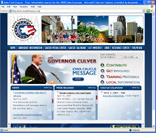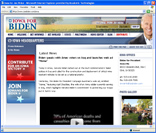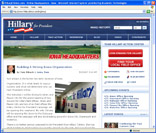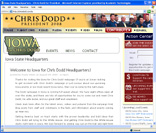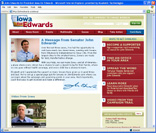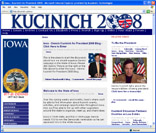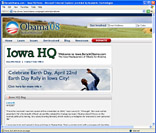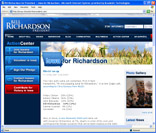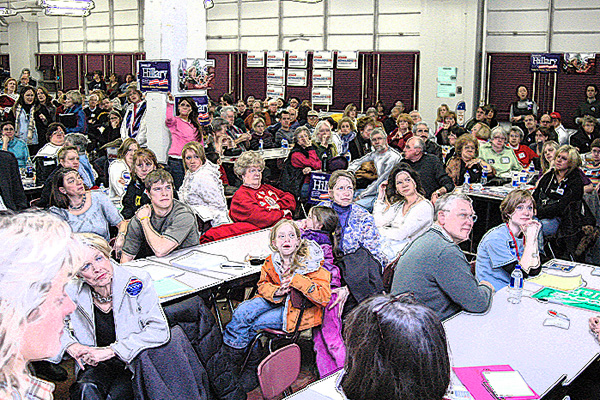The Iowa caucuses are the first step in the nominating processes of the Democratic and Republican parties. As a result, Iowa garners a vastly disproportionate number of candidate visits and amount of media attention. A better than expected showing on caucus night can boost a candidacy, while a poor performance can spell the end of a candidate's hopes.
| Biden | Clinton | Dodd | Edwards | Gravel | Kucinich | Obama | Richardson | . | Didn't Run | . | ||
| Cox | Giuliani | Huckabee | Hunter | McCain | Paul | Romney | F.Thompson |

|

|

|

|

|
First-in-the-Nation
| Iowa
Code--Title II
Chapter 43.4:
Delegates to county conventions of political parties and party committee members shall be elected at precinct caucuses held not later than the fourth Monday in February of each even-numbered year. The date shall be at least eight days earlier than the scheduled date for any meeting, caucus or primary which constitutes the first determining stage of the presidential nominating process in any other state, territory or any other group which has the authority to select delegates in the presidential nomination. The state central committees of the political parties shall set the date for their caucuses... |
Early Groundwork
About a dozen potential candidates from each party
worked to cultivate good will and
build
connections in Iowa in the months and years leading up to the
caucuses.
Most obviously, they made numerous visits to
the state in 2005-06. The closely split Iowa legislature
(Republicans
had a 51 to 49 majority in the House and the Senate was tied at 25 to
25),
several close congressional races, and the gubernatorial campaign
provided
a convenient excuse for many visits by '08 presidential
prospects.
[2006
campaigns]. By Election Day, Nov. 7, 2006, 13
potential Republican candidates had made 70 visits totaling 112 days
and
11 potential Democratic candidates had made 60 visits totaling 108
days.
[See
also Iowa
Visits
2004]. (In the 2006 mid-terms, Iowa Democrats
fared
very well, gaining a 54D to 45R, 1O majority in the House and a 30D to
20R majority in the Senate, winning two U.S. House seats and holding
the
governorship).
There were many ways in addition to actually traveling to Iowa that prospective candidates could engage Iowans. Sen. Hillary Rodham Clinton (D-NY), seen as the Democratic frontrunner, did not visit Iowa at all in 2005-06. A candidate or potential candidate could hold low-key meetings in his or her office or home, make calls, send Christmas cards, or address groups of Iowans without traveling to the state. In 2004 some prospects stopped by to speak to the Iowa delegations during the respective national party conventions.
Hopefuls also made early efforts to attract talent. By mid-2006 several of the '08 prospects had announced Iowa chairmen or coordinators of their leadership PACs and advisory committees. The leadership PACs made generous contributions to candidates and party committees in Iowa (and elsewhere) and even paid for staff to work on Iowa campaigns. In mid-August 2006, for example, Sen. Evan Bayh's (D-IN) All America PAC announced it was placing 25 graduates of its campaign training program to work as paid staffers on state, local and congressional races in Iowa. Other leadership PACs did this type of thing on a more modest scale.
Independent of a candidate or potential candidate's efforts, citizens and organized groups started up efforts to build support for or to criticize some of the presidential hopefuls. Several Iowa activists launched blogs in support of particular candidates. Additionally a few interest groups tried leveraging small media buys criticizing one or another of the presidential prospects to gain attention.
Dynamics
Iowa's precinct caucuses were tentatively scheduled
to take place on the evening of Jan. 14, 2008; that was the date
penciled
in on calendars for much of 2007. However, the jostling of other
states seeking to go early made it likely that the date would move;
there
was even talk that the caucuses might occur in Dec. 2008.
Finally,
in Oct. 2007 both parties announced Jan. 3, 2008 as the caucus date. [RPI
press release, IDP
press release, 2].
Meanwhile pundits debate whether the "super duper primary" on Feb. 5,
2008
made a strong showing in Iowa even more important than it has been in
past.
For most campaigns, not competing in Iowa was not seen as an option. John McCain tried it in 2000 and Wesley Clark tried it in 2004. An internal memo by Clinton deputy campaign manager Mike Henry, leaked to the AP on May 23, 2007, suggested that Clinton bypass the Iowa caucuses to focus on later contests, but the campaign disavowed that notion and competed hard in the state. Even candidates like McCain and Giuliani, who focused much of their efforts elsewhere, spent some time in Iowa.
Labor forms an important constituency for Democratic candidates. The state party is led by chairman Scott Brennan, and Norm Sterzenbach is serving as the IDP political and caucus director, charged with organizing the party's caucuses. For a while it looked as if the campaign of Gov. Tom Vilsack, whose term ended in January 2007, might affect the dynamics of the Democratic race, but he withdrew on Feb. 23, 2007 citing money; on March 26 he endorsed Sen. Hillary Clinton. Conventional wisdom had it that the frontrunners were Sen. Clinton, former Sen. Edwards, and Sen. Obama. Sen. Biden, Sen. Dodd and Gov. Richardson also invested major time and resources in the state and built credible organizations. Edwards had the advantage of being able to build upon his 2004 campaign. Obama built a strong field organization early and drew consistently big crowds. Clinton also built an extensive field organization and hoped to be able to leverage the women's vote.
On the Republican side, social conservatives form an important constituency. The Republican Party of Iowa re-elected Ray Hoffmann to a second term as chairman on Jan. 13, 2007. The Iowa Republican Straw Poll, held on Aug. 11, 2007, was one of the determining events of the Republican caucus campaign. While the Giuliani and McCain campaigns' decisions not to participate lessened the impact of the event somewhat, and former Gov. Mitt Romney prevailed as expected, the Straw Poll did give a significant boost to former Gov. Mike Huckabee, knocked former Gov. Tommy Thompson out of the race, seriously dampened the hopes of Sen. Sam Brownback (he held on for a couple of months but bowed out on Oct. 19), and did not help Rep. Tom Tancredo. Romney was seen as the frontrunner until the Fall, but Huckabee started gaining strength in November. Former Mayor Giuliani, Sen. McCain, Rep. Paul, Rep. Tancredo, and former Sen. Thompson all waged credible campaigns.
Iowans, like Americans everywhere, want to learn candidates' views on Iraq, education and health care and other issues, but the candidates must be also prepared to address questions relating to agriculture, the rural economy, and ethanol. Agriculture is obviously important, but Iowa has an increasingly diversified economy and leaders have sought to counter a one-dimensional stereotype of the state.
Candidates seeking to get their messages out face several communications challenges. First is the large number of candidates. Unlike in 2003-04 where just Democrats were running, both Democrats and Republicans crowded into the Hawkeye State. Second, the proximity of the caucuses to the Christmas holiday meant the campaigns had to work around that in addition to vying with commercial advertisers' holiday pitches.
Organize, Organize, Organize.
Iowa has a population of about three
million,
and its ninety-nine counties provide plenty
of
ground for candidates to cover. Des Moines, in the center of the
state, has a metro area population of about 500,000 (Core-Based
Statistical
Area (CBSA); the population of Polk County is a little over
400,000).
At the other extreme is Adams County in the Southwest part of the state
with a population of less than 4,500. In
the 2004 Democratic caucuses there were 1,993 precincts although some
of
these shared locations. This time there are 1,781 precincts (it
was
1784 until a last-minute precinct consolidation by the Board of
Supervisors
in Washington County).
The major job for the campaigns in 2007 was to identify committed supporters, likely supporters, and persuadables (1's, 2's and 3's as they are called). Republican and Democratic campaigns took decidely different approaches to this task. The campaigns of the leading major Democratic candidates had very large staffs and a dozen or more (Clinton and Obama both have more than 30) field offices around the state, while the Republican campaign organizations were much smaller. The campaigns devoted much work to building a team of committed county chairs and precinct captains. and they also made considerable efforts to obtain endorsements from state and local officials, who might be able to sway their neighbors and acquaintances. In terms of the air war, those campaigns that had money ran TV ads, in some cases lots of them. According to a Wisconsin Advertising Project analysis of TNS Media Intelligence data a total of $43 million was spent on presidential campaign advertising in the Iowa caucus campaign. In the closing weeks caucus-goers were also deluged with mail and phone calls.
updated Aug. 15, 2008 to reflect two missed days (Romney in June and Kucinich in November)
|
|
|
|
|
|
|
|
|
|
|
|
|
|
|
|
|
|
|
|
|
|
|
|
|
|
|
|
|
|
|
|
|
|
|
|
|
|
|
|
|
|
|
|
|
|
|
|
|
|
|
|
|
|
|
|
*Does not include John Cox (R), Alan Keyes (R), Mike Gravel (D) and Tom Vilsack (D).
**Dec. '07 entries include Jan. 1-3, '08.
Exchanges with a friend, neighbor, colleague or fellow Iowan can have an important effect on a caucus-goer's thinking. Even more telling are first-hand impressions of the candidates. Candidates plied the state with visits. From Jan. 1, 2007 to Jan. 3, 2008 11 Republican candidates made 211 visits totaling 441 days, while seven Democratic candidates made 199 visits totaling 533 days. Thus the campaign among the Democrats was particularly intense--fewer candidates spent considerably more time in state than on the GOP side. Republican visits tailed off after the August Straw Poll. Looking at the 2008 cycle Biden, Dodd and Edwards made the "hundred days in Iowa club," and Biden and Dodd accomplished that feat in 2007 alone. Dodd even rented a place in Des Moines and brought his family there starting in October. (Cox also spent 100-plus days in Iowa, but is not considered in this analysis). Edwards, Richardson and Tommy Thompson (and likely Cox) made the "99-county club." Finally if one looks at the whole cycle from Nov. 2004 post-election through Jan. 3, 2008, Republican prospects and candidates made 283 visits totaling 550 days and Democratic prospects and candidates made 265 visits totaling 648 days for a grand total of 1,198 days.
Much organizing activity occurs around candidate visits. If a campaign has any kind of organization, a field organizer or field organizers bearing supporter cards will approach attendees after an event. Having a staff that can translate the energy and interest generated by the candidate into actual Iowans willing to volunteer time and effort and to head out on that cold evening in January to spend a couple of hours in a caucus meeting is essential.
The Day Arrives
Brian Duffy's cartoon on the front-page
of the Jan. 3, 2008 Des Moines Register shows the candidates
standing
on the palm of caucus-goer's hand. After all the activity and the
millions spent and the pundits' pontificating and the polls it is
finally
in the hands of Iowans [pledge,
college
student
participation]. Democrats and Republicans use
different processes [many of the campaigns produced videos
to explain the caucus process]. The precinct caucuses on
the
evening of January 3 were but a first step in selecting delegates to
the
national conventions, both processes will conclude with state
conventions
in June 2008.
In terms of complexity, the Republican and Democratic systems are as different as checkers and chess. Republican caucuses are actually straw polls; candidates are simply trying to get the most total votes, and the outcome has no bearing on the selection of delegates. Democratic caucuses determine selection of delegates to county conventions and thence to district conventions and the state convention. One very important feature of the Democratic precinct caucuses is the 15-percent threshhold (in most precincts) to achieve viability; this means that if a caucus-goer's candidate fails to achieve that level, he or she must align with another group or go home. Thus if a caucus-goer favored one of the "second-tier" candidates, his or her second choice was a matter of great interest to the other campaigns. The net result can be some very interesting negotiations. Dennis Kucinich issued a statement on Jan. 1, 2008 urging his supporters to make Barack Obama their second choice; in 2004 he had pointed them to John Edwards. While caucus math can be confusing, ultimately what is being determined are the 2,500 delegates to the state convention. [See: Iowa Democratic Party Delegates to the 2008 State Convention by County].
For the candidates, what matters is
what
happens on caucus night and makes headlines the next day. Both
parties
reported record turnouts -- 239,000 caucus goers for the Democrats and
more than 118,000 for the Republicans. (By comparison on Jan. 19,
2004 just 124,331 people participated in the Democratic
caucuses).
Huckabee was the clear winner on the Republican side, given the
millions
that Romney had spent. The Democratic race had been seen as too
close
to call between the three frontrunners. Obama's win by a somewhat
wider margin than expectations provided a boost. Edwards' finish,
quite a bit behind Obama and just slightly ahead of Clinton, was not as
strong as might have been expected given the time he invested in the
state
going back to the 2004 campaign. He did not get the push he
needed
going into later contests. For Clinton Iowa was a wake up
call.
On the plane going out of Des Moines the next morning there was some
talk
that her campaign was "toast." As for other candidates, Biden and
Dodd ended their campaigns on the night of Jan. 3 in Des Moines.
Richardson hung on until after New Hampshire.
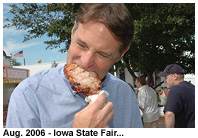 |
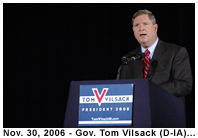 |
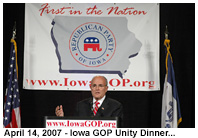 |
Aug. 11, 2007-Iowa Republican Straw Poll |
Official Sites
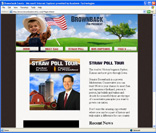 www.brownbackevents.com (June 10 grab) |
 www.mikehuckabee.com/index.cfm? FuseAction=IowaHQ.Home (July 6 grab) |
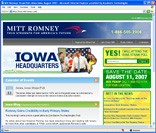 iowa.mittromney.com (July 15 grab) |
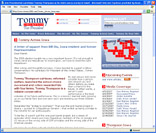 www.tommy2008.com/Tommy_Across_Iowa.aspx (May 28 grab) |
